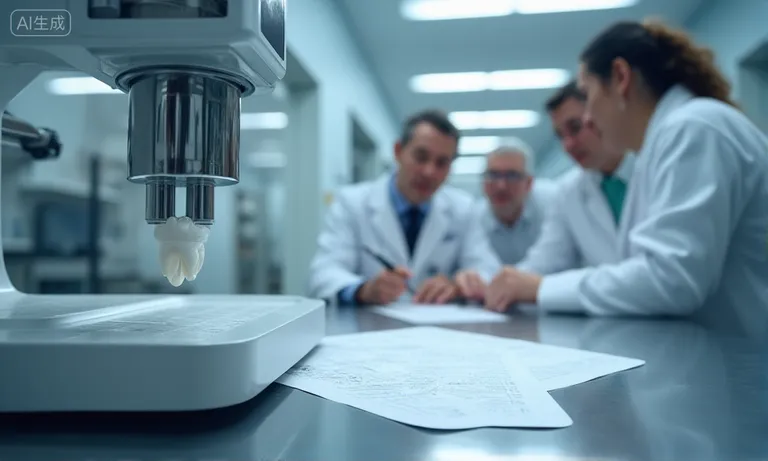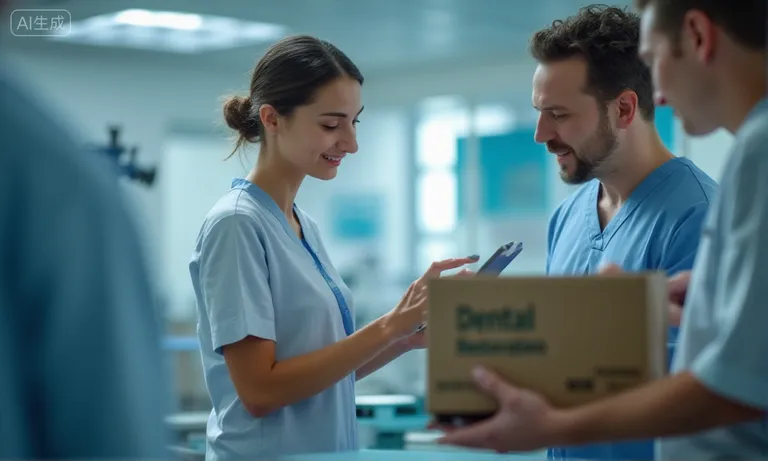3D printing can be a cost-effective outsourcing solution for dental implant lab work, but its value goes far beyond the unit price on a quotation. For practices and procurement teams, the real question is whether outsourcing provides predictable financial efficiency over time.
Key considerations include:
- Direct cost differences — greater material efficiency, reduced manual labor, and fewer remakes compared to traditional methods.
- Long-term ROI — understanding the break-even point and ensuring outsourcing remains viable for both high and fluctuating case volumes.
- Logistics and hidden costs — shipping, customs, and unanticipated fees that can alter the total cost equation.
- Beyond price — reliability, workflow stability, and consistent quality as drivers of sustainable value.
- Transparent pricing — structured quotations that prevent hidden risks and enable accurate forecasting.
By focusing on these financial dimensions, buyers can determine whether outsourcing to a 3D-printing-capable dental lab delivers not only immediate savings but also long-term value and greater confidence in procurement decisions.
What Are the Direct Cost Differences Between 3D Printing and Traditional Methods?
The cost differences between 3D printing and traditional methods go beyond the surface of unit price. Additive workflows, reduced manual steps, and lower remake rates make digital production often more cost-effective than conventional milling or casting.

Dental-Lab-3DPrinting-vs-Traditional-Cost
Material efficiency: additive vs subtractive workflows
Additive manufacturing uses only the material required to build the restoration layer by layer, leaving minimal waste. Traditional subtractive methods, such as milling zirconia blocks, result in large amounts of unused material. For labs handling high-volume production, this difference becomes financially significant:
- 3D printing: resin and metal powders consumed only where needed.
- Traditional milling: up to 60–70% of a block may be discarded.
- Buyer value: lower material waste = more predictable margins.
Labor intensity: automated printing vs manual steps
Automation in 3D printing reduces reliance on extensive manual labor:
- 3D printing: once files are prepared, the printer operates autonomously for several hours.
- Traditional workflows: technicians perform multiple steps such as waxing, casting, and manual adjustments.
- Buyer value: fewer manual steps reduce labor costs and free technicians for quality control instead of repetitive tasks.
How remake rates and quality consistency affect total cost
One hidden cost factor is remake frequency. Traditional methods are more prone to variation, especially when impressions distort or margins are adjusted manually. Digital 3D printing workflows integrate CAD accuracy, which reduces fit-related remakes. Fewer remakes mean fewer lost hours and less wasted material. For buyers, this translates into more predictable costs and fewer financial surprises.
Direct cost savings from 3D printing are not only about “cheaper per crown.” They come from material efficiency, reduced labor dependency, and improved consistency. Procurement teams comparing outsourcing options should weigh these factors, as they reveal the true difference between modern digital workflows and traditional methods.
How Does 3D Printing Outsourcing Impact Long-Term ROI?
Outsourcing 3D printing can deliver strong long-term ROI when buyers consider not just single-unit cost but also scaling potential, workload flexibility, and opportunity cost. The value lies in predictable production that avoids capital-heavy investments while ensuring consistent delivery.

Dental-Lab-3DPrinting-Outsourcing-ROI
Understanding the break-even point in outsourcing vs scaling
The break-even decision often determines whether a lab invests in equipment or outsources.
| Scenario | In-House 3D Printing | Outsourcing |
|---|---|---|
| Initial investment | High (equipment, training, software) | Low (per-case fee) |
| Ongoing costs | Maintenance, staff, material stock | Predictable unit pricing |
| Risk | Idle machines if demand fluctuates | Scalable cost, pay-as-needed |
For small and mid-sized buyers, outsourcing keeps upfront cost low and allows flexible entry without sunk capital.
Cost benefits in high-volume or repeat cases
- Bulk outsourcing reduces per-unit cost by leveraging lab capacity.
- Repeat cases like full-arch bridges gain efficiency through pre-set design libraries.
- Buyer advantage: long-term partnerships with high case volume often secure better pricing tiers, making outsourcing more cost-efficient over time.
How workload fluctuations affect outsourcing cost-effectiveness
Demand for implant restorations often fluctuates across months. In-house systems risk downtime when demand is low and overcapacity stress when demand spikes. Outsourcing transfers this risk to the lab, where capacity is absorbed across multiple clients. This flexibility allows procurement teams to pay only for cases produced, maintaining cost efficiency even in unpredictable cycles.
Opportunity cost of scaling in-house vs outsourcing
A hidden but critical factor is opportunity cost. Investing in equipment, staff, and space ties capital that could otherwise fund clinical expansion, marketing, or patient services. Outsourcing frees buyers from these commitments, enabling them to scale operations without financial lock-in. In practice, many clinics discover that ROI improves when resources are directed toward patient-facing growth rather than internal lab expansion.
When viewed through ROI, outsourcing is more than a short-term saving—it’s a way to align financial resources with strategic priorities. Labs that can demonstrate scalability, predictable pricing, and workload flexibility are the ones that deliver sustainable value.
What Role Do Shipping and Logistics Play in the Overall Cost Equation?
Shipping and logistics can significantly influence the true cost of outsourcing dental implant work. While 3D printing lowers production costs, delays or hidden fees in transport can quickly erode financial advantages. Procurement teams need to weigh both local and overseas options with realistic cost expectations.

Dental-Lab-Logistics-Costs
Local vs overseas outsourcing: balancing price with delivery lead time
| Factor | Local Labs | Overseas Labs |
|---|---|---|
| Unit price | Higher (labor + overhead) | Lower (scale + automation) |
| Delivery time | Same-day or 1–2 days | 3–7 days typical |
| Risk exposure | Minimal logistics risk | Customs, transit delays possible |
| Buyer value | Faster chairside support | Lower cost at scale |
This trade-off is central: local labs deliver speed, while overseas labs deliver cost savings, provided logistics are well managed.
Customs, tariffs, and hidden fees to consider
Cross-border shipments introduce hidden costs. Customs clearance fees, import tariffs, and courier surcharges can add 10–20% to the expected bill if not disclosed upfront. Inconsistent paperwork or incomplete documentation may trigger additional charges, sometimes exceeding the savings from lower unit price. Buyers must factor these into total cost projections when evaluating overseas partners.
How reliable logistics reduce the risk of extra expenses
Reliable logistics partners and standardized shipping processes minimize risk of extra costs:
- End-to-end tracking provides transparency in case handling.
- Clear customs documentation prevents unnecessary delays.
- Preferred courier agreements reduce variability in shipping charges.
- Integrated communication between clinic and lab ensures cases are monitored in real time.
Procurement managers who look beyond the production fee to include logistics will have a more accurate picture of outsourcing cost. Well-structured shipping processes allow overseas dental labs to remain competitive and predictable even across borders.
Why Cost-Effectiveness Goes Beyond the Lowest Price
Cost-effectiveness in implant outsourcing is not about securing the lowest unit price—it is about avoiding hidden risks that create larger financial losses over time. Buyers who focus only on upfront savings may overlook the true drivers of long-term value: stability, quality, and partnership reliability.

Dental-Lab-Cost-vs-Value
The hidden expense of delays, communication gaps, and unstable supply
A crown that costs $10 less per unit loses its advantage if delivery is delayed by a week. Communication breakdowns or supply interruptions force clinics to reschedule patients, incur opportunity cost, and absorb reputational damage. These indirect losses often outweigh the benefit of lower invoice prices.
How lower remake rates reduce long-term financial risk
- Digital-first workflows mean higher initial accuracy.
- Lower remake rates prevent re-delivery cycles and wasted chairtime.
- Buyer advantage: fewer remakes translate into lower hidden costs and steadier operational budgets.
Balancing unit price with quality, stability, and partnership reliability
The real measure of cost-effectiveness is not the lowest quote but the ability to deliver predictable quality at scale. Procurement managers should weigh unit price against reliability signals—workflow automation, SOP consistency, and transparent logistics. Overseas partners who combine competitive pricing with proven delivery records offer stronger long-term value than cheaper but unstable alternatives. As a reliable overseas dental lab, Raytops Dental Lab has seen that buyers value predictable performance more than marginal discounts when it comes to multi-year collaboration.
How Can Buyers Evaluate Whether a Lab’s Pricing Model Is Transparent and Fair?
A transparent pricing model allows buyers to forecast costs accurately and avoid unpleasant surprises. The ability of a lab to present clear and predictable quotations is a strong signal of reliability, often just as important as turnaround time or quality.

Dental-Lab-Transparent-Pricing
Signs of a structured and predictable pricing model
- Standardized fee schedules instead of case-by-case negotiation.
- Clear tiering for single-unit vs multi-unit restorations.
- Consistency over time, showing stable pricing unaffected by small market fluctuations.
What should be clearly included in a quotation (materials, shipping, remake policy)
| Essential Item | Why It Matters | Buyer Benefit |
|---|---|---|
| Materials | Differentiate zirconia, cobalt-chrome, resin | Prevents hidden upcharges |
| Shipping | Local vs overseas rates, courier method | Accurately forecast logistics costs |
| Remake policy | Coverage of reworks or adjustments | Protects against financial surprises |
Red flags indicating hidden costs or unstable pricing
- Vague line items such as “miscellaneous fees.”
- Frequent unexplained price changes.
- Lack of clarity on remake or re-delivery charges.
- Shipping or customs charges not itemized in advance.
Procurement teams that demand detailed and structured quotations reduce financial risk and establish more predictable partnerships. Labs that present clear pricing—including all materials, shipping, and remake terms—are signaling long-term stability. Overseas partners like Raytops Dental Lab demonstrate this by offering structured pricing and transparent quotations, ensuring buyers can trust both the numbers and the delivery.
Conclusion
3D printing is not just a technological upgrade—it is a way for dental implant labs and buyers to achieve true cost-effectiveness. When evaluated across material efficiency, labor savings, remake reduction, logistics planning, and pricing transparency, outsourcing delivers more than short-term savings. The real value lies in predictable costs, scalable delivery, and reliable partnerships. By working with an overseas dental lab that combines structured pricing with stable performance, procurement teams can secure both financial efficiency and long-term confidence in their restorative supply chain.


